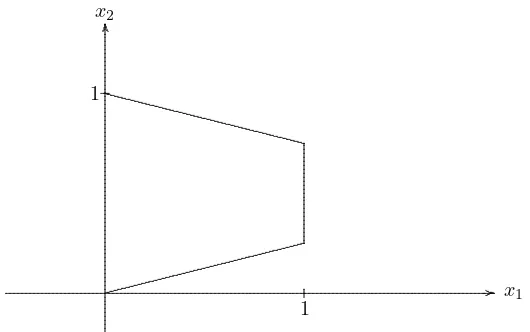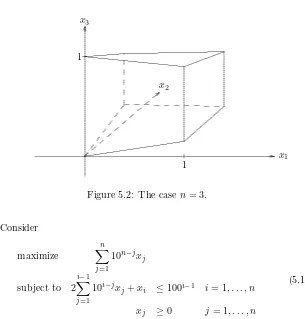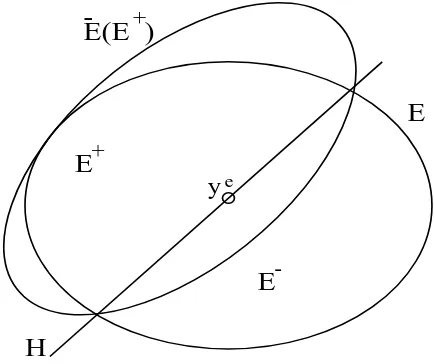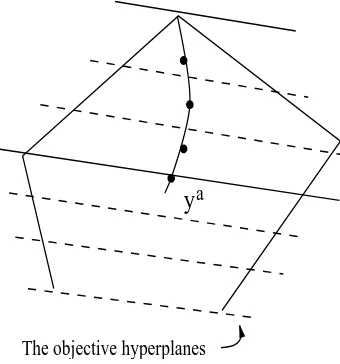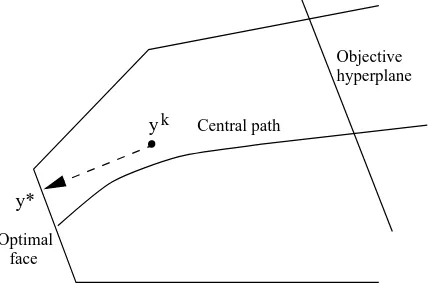Programming”
David G. Luenberger and Yinyu Ye
Contents
Preface
ix
List of Figures
xi
5
Interior-Point Algorithms
117
5.1
Introduction . . . .
117
5.2
The simplex method is not polynomial-time
∗
. . . .
120
5.3
The Ellipsoid Method . . . .
125
5.4
The Analytic Center . . . .
128
5.5
The Central Path . . . .
131
5.6
Solution Strategies . . . .
137
5.6.1
Primal-dual path-following
. . . .
139
5.6.2
Primal-dual potential function
. . . .
141
5.7
Termination and Initialization
∗
. . . .
144
5.8
Notes
. . . .
148
5.9
Exercises
. . . .
149
12 Penalty and Barrier Methods
153
12.9 Convex quadratic programming . . . .
153
12.10Semidefinite programming . . . .
154
12.11Notes
. . . .
158
12.12Exercises
. . . .
159
Bibliography
160
Index
409
Preface
List of Figures
5.1
Feasible region for Klee-Minty problem;
n
= 2. . . .
121
5.2
The case
n
= 3. . . .
122
5.3
Illustration of the minimal-volume ellipsoid containing a
half-ellipsoid. . . .
127
5.4
The central path as analytic centers in the dual feasible region.135
5.5
Illustration of the projection of an interior point onto the
optimal face.
. . . .
146
Chapter 5
Interior-Point Algorithms
5.1
Introduction
Linear programming (LP), plays a distinguished role in optimization theory.
In one sense it is a continuous optimization problem since the goal is to
minimize a linear objective function over a convex polyhedron. But it is
also a combinatorial problem involving selecting an extreme point among
a finite set of possible vertices, as seen in Chapters 3 and 4.
An optimal solution of a linear program always lies at a vertex of the
feasible region, which itself is a polyhedron. Unfortunately, the number of
vertices associated with a set of
n
inequalities in
m
variables can be
expo-nential in the dimension—up to
n!/m!(n
−
m)!. Except for small values of
m
and
n, this number is sufficiently large to prevent examining all possible
vertices when searching for an optimal vertex.
The simplex method examines optimal candidate vertices in an
intel-ligent fashion. As we know, it constructs a sequence of adjacent vertices
with improving values of the objective function. Thus, the method travels
along edges of the polyhedron until it hits an optimal vertex. Improved in
various way in the intervening four decades, the simplex method continues
to be the workhorse algorithm for solving linear programming problems.
Although it performs well in practice, the simplex method will examine
every vertex when applied to certain linear programs. Klee and Minty in
1972 gave such an example. These examples confirm that, in the worst
case, the simplex method uses a number of iterations that is exponential
in the size of the problem to find the optimal solution. As interest in
complexity theory grew, many researchers believed that a good algorithm
should be polynomial —that is, broadly speaking, the running time required
to compute the solution should be bounded above by a polynomial in the
size, or the total data length, of the problem. The simplex method is not
a polynomial algorithm.
1
In 1979, a new approach to linear programming, Khachiyan’s ellipsoid
method, received dramatic and widespread coverage in the international
press. Khachiyan proved that the ellipsoid method, developed during the
1970s by other mathematicians, is a polynomial algorithm for linear
pro-gramming under a certain computational model. It constructs a sequence
of shrinking ellipsoids with two properties: the current ellipsoid always
con-tains the optimal solution set, and each member of the sequence undergoes
a guaranteed reduction in volume, so that the solution set is squeezed more
tightly at each iteration.
Experience with the method, however, led to disappointment. It was
found that even with the best implementations the method was not even
close to being competitive with the simplex method.
Thus, after the
dust eventually settled, the prevalent view among linear programming
re-searchers was that Khachiyan had answered a major open question on the
polynomiality of solving linear programs, but the simplex method remained
the clear winner in practice.
This contradiction, the fact that an algorithm with the desirable
the-oretical property of polynomiality might nonetheless compare unfavorably
with the (worst-case exponential) simplex method, set the stage for
excit-ing new developments. It was no wonder, then, that the announcement by
Karmarkar in 1984 of a new polynomial time algorithm, an interior-point
method, with the potential to improve the practical effectiveness of the
simplex method made front-page news in major newspapers and magazines
throughout the world.
Interior-point algorithms are continuous iterative algorithms.
Computa-tional experience with sophisticated procedures suggests that the number
of necessary iterations grows very slowly with problem size. This
pro-vides the potential for improvements in computation effectiveness for
solv-ing large-scale linear programs. The goal of this chapter is to provide
some understanding on the complexity theories of linear programming and
polynomial-time interior-point algorithms.
A few words on complexity theory
5.1.
INTRODUCTION
119
measuring the effectiveness of various algorithms (and thus, be able to
com-pare algorithms using these criteria), and to assess the inherent difficulty
of various problems.
The term
complexity
refers to the amount of resources required by a
computation. In this chapter we focus on a particular resource, namely,
computing time. In complexity theory, however, one is not interested in
the execution time of a program implemented in a particular programming
language, running on a particular computer over a particular input. This
involves too many contingent factors. Instead, one wishes to associate to
an algorithm more intrinsic measures of its time requirements.
Roughly speaking, to do so one needs to define:
•
a notion of
input size,
•
a set of
basic operations, and
•
a
cost
for each basic operation.
The last two allow one to associate a
cost of a computation. If
x
is any
input, the cost
C(x) of the computation with input
x
is the sum of the
costs of all the basic operations performed during this computation.
Let
A
be an algorithm and
In
be the set of all its inputs having size
n.
The
worst-case cost function
of
A
is the function
T
w
A
defined by
T
w
A
(n) = sup
x∈In
C(x).
If there is a probability structure on
In
it is possible to define the
average-case cost function
T
a
A
given by
T
a
A(n) = En(C(x)).
where En
is the expectation over
In. However, the average is usually more
difficult to find, and there is of course the issue of what probabilities to
assign.
the size of an element is usually taken to be 1 and consequently to have
unit size
per number.
Examples of the second are integer numbers which require a number
of bits approximately equal to the logarithm of their absolute value. This
(base 2) logarithm is usually referred to as the
bit size
of the integer. Similar
ideas apply for rational numbers.
Let
A
be some kind of data and
x
= (x
1
, . . . , xn
)
∈
A
n
. If
A
is of
the first kind above then we define size(
x
) =
n. Otherwise, we define
size(
x
) =
P
n
i
=1
bit-size(xi
).
The cost of operating on two unit-size numbers is taken to be 1 and is
called
unit cost. In the bit-size case, the cost of operating on two numbers
is the product of their bit-sizes (for multiplications and divisions) or its
maximum (for additions, subtractions, and comparisons).
The consideration of integer or rational data with their associated bit
size and bit cost for the arithmetic operations is usually referred to as the
Turing model of computation. The consideration of idealized reals with unit
size and unit cost is today referred as the
real number arithmetic model.
When comparing algorithms, one should make clear which model of
com-putation is used to derive complexity bounds.
A basic concept related to both models of computation is that of
poly-nomial time. An algorithm
A
is said to be a polynomial time algorithm if
T
w
A
is bounded above by a polynomial. A problem can be solved in
polyno-mial time if there is a polynopolyno-mial time algorithm solving the problem. The
notion of
average polynomial time
is defined similarly, replacing
T
w
A
by
T
a
A.
The notion of polynomial time is usually taken as the formalization of
efficiency and it is the ground upon which complexity theory is built.
5.2
The simplex method is not
polynomial-time
∗
When the simplex method is used to solve a linear program in standard
form with the coefficient matrix
A
∈
R
m×n
,
b
∈
R
m
and
c
∈
R
n
, the
number of iterations to solve the problem starting from a basic feasible
solution is typically a small multiple of
m: usually between 2m
and 3m.
In fact, Dantzig observed that for problems with
m
≤
50 and
n
≤
200 the
number of iterations is ordinarily less than 1.5m.
5.2.
THE SIMPLEX METHOD IS NOT POLYNOMIAL-TIME
∗
121
Figure 5.1: Feasible region for Klee-Minty problem;n
= 2.
paper that exhibited a class of linear programs each of which requires an
exponential number of iterations when solved by the conventional simplex
method.
As originally stated, the Klee–Minty problems are not in standard form;
they are expressed in terms of 2n
linear inequalities in
n
variables. Their
feasible regions are perturbations of the
unit cube
in
n-space; that is,
[0,
1]
n
=
{x
: 0
≤
xj
≤
1,
j
= 1, . . . , n}.
One way to express a problem in this class is
maximize
xn
subject to
x
1
≥
0
x
1
≤
1
xj
≥
εxj
−1
j
= 2, . . . , n
xj
≤
1
−
εxj
−1
j
= 2, . . . , n
where 0
< ε <
1/2.
This presentation of the problem emphasizes the idea
that the feasible region of the problem is a perturbation of the
n-cube.
In the case of
n
= 2 and
ε
= 1/4, the feasible region of the linear
program above looks like that of Figure 5.1
.
subject to
2
i
−
1
The problem above is easily cast as a linear program in standard form.
Example 5.1
Suppose we want to solve the linear program
maximize
100x
1
+ 10x
2
+
x
3
subject to
x
1
≤
1
20x
1
+
x
2
≤
100
200x
1
+ 20x
2
+
x
3
≤
10,
000
5.2.
THE SIMPLEX METHOD IS NOT POLYNOMIAL-TIME
∗
123
T
0
Variable
x1
x2
x3
x4
x5
x6
b
4
1
0
0
1
0
0
1
5
20
1
0
0
1
0
100
6
200
20
1
0
0
1
10,000
c
T
100
10
1
0
0
0
0
•
•
•
The bullets below the tableau indicate the columns that are basic.
Note that we are maximizing, so the goal is to find a feasible basis that
prices out
nonpositive
. In the objective function, the nonbasic variables
x1, x2,
and
x3
have coefficients 100, 10, and 1, respectively. Using the
greedy rule
2
for selecting the incoming variable (see Section 3.8, Step 2
of the revised simplex method), we start making
x1
positive and find (by
the minimum ratio test) that
x4
becomes nonbasic. After pivoting on the
element in row 1 and column 1, we obtain a sequence of tables:
T
1
Variable
x1
x2
x3
x4
x5
x6
b
1
1
0
0
1
0
0
1
5
0
1
0
–20
1
0
80
6
0
20
1
–200
0
1
9,800
r
T
0
10
1
–100
0
0
–100
•
•
•
T
2
Variable
x1
x2
x3
x4
x5
x6
b
1
1
0
0
1
0
0
1
2
0
1
0
–20
1
0
80
6
0
0
1
200
–20
1
8,200
r
T
0
0
1
100
–10
0
–900
•
•
•
T
3
Variable
x1
x2
x3
x4
x5
x6
b
4
1
0
0
1
0
0
1
2
20
1
0
0
1
0
100
6
–200
0
1
0
–20
1
8,000
r
T
–100
0
1
0
–10
0
–1,000
•
•
•
T
4
Variable
x1
x2
x3
x4
x5
x6
b
4
1
0
0
1
0
0
1
2
20
1
0
0
1
0
100
3
–200
0
1
0
–20
1
8,000
r
T
100
0
0
0
10
–1
–9,000
•
•
•
T
5
Variable
x1
x2
x3
x4
x5
x6
b
1
1
0
0
1
0
0
1
2
0
1
0
–20
1
0
80
3
0
0
1
200
–20
1
8,200
r
T
0
0
0
–100
10
–1
–9,100
•
•
•
T
6
Variable
x1
x2
x3
x4
x5
x6
b
1
1
0
0
1
0
0
1
5
0
1
0
–20
1
0
80
3
0
20
1
–200
0
1
9,800
r
T
0
–10
0
100
0
–1
–9,900
•
•
•
T
7
Variable
x1
x2
x3
x4
x5
x6
b
4
1
0
0
1
0
0
1
5
20
1
0
0
1
0
100
3
200
20
1
0
0
1
10,000
r
T
–100
–10
0
0
0
–1
–10,000
•
•
•
From T
7
we see that the corresponding basic feasible solution
(x1, x2, x3, x4, x5, x6) = (0,
0,
10
4
,
1,
10
2
,
0)
is optimal and that the objective function value is 10
,
000
.
Along the way,
we made 2
3
−
1 = 7 pivot steps. The objective function strictly increased
with each change of basis.
We see that the instance of the linear program (5.1) with
n
= 3 leads to
2
3
−
1 pivot steps when the greedy rule is used to select the pivot column.
The general problem of the class (5.1) takes 2
n
−
1 pivot steps. To get
an idea of how bad this can be, consider the case where
n
= 50. Now
2
50
−
1
≈
10
15
.
In a year with 365 days, there are approximately 3
×
10
7
seconds. If a computer ran continuously performing a hundred thousand
iterations of the simplex algorithm per second, it would take approximately
10
15
3
×
10
5
×
10
8
≈
33 years
to solve the problem using the greedy pivot selection rule
3
.
3
5.3.
THE ELLIPSOID METHOD
125
5.3
The Ellipsoid Method
The basic ideas of the ellipsoid method stem from research done in the
nineteen sixties and seventies mainly in the Soviet Union (as it was then
called) by others who preceded Khachiyan. The idea in a nutshell is to
enclose the region of interest in each member of a sequence of ever smaller
ellipsoids.
The significant contribution of Khachiyan was to demonstrate in two
papers—published in 1979 and 1980—that under certain assumptions, the
ellipsoid method constitutes a polynomially bounded algorithm for linear
programming.
The method discussed here is really aimed at finding a point of a
poly-hedral set Ω given by a system of linear inequalities.
Ω =
{
y
∈
R
m
:
y
T
a
j
≤
cj,
j
= 1, . . . n}
Finding a point of Ω can be thought of as being equivalent to solving a
linear programming problem.
Two important assumptions are made regarding this problem:
(A1) There is a vector
y0
∈
R
m
and a scalar
R >
0 such that the closed
ball
S(y0
, R) with center
y0
and radius
R, that is
{
y
∈
R
m
:
|
y
−
y0
| ≤
R},
contains Ω.
(A2) There is a known scalar
r >
0 such that if Ω is nonempty, then it
contains a ball of the form
S(y
∗
, r) with center at
y
∗
and radius
r. (This assumption implies that if Ω is nonempty, then it has a
nonempty interior and its volume is at least vol(S(0, r)))
4
.
Definition 5.1
An
Ellipsoid
in
R
m
is a set of the form
E
=
{y
∈
R
m
: (y
−
z)
T
Q(y
−
z)
≤
1}
where
z
∈
R
m
is a given point (called the
center) and
Q
is a positive definite
matrix (see Section A.4 of Appendix A) of dimension
m. This ellipsoid is
denoted ell(z,
Q).
The unit sphere
S(0,
1) centered at the origin
0
is a special ellipsoid
with
Q
=
I
, the identity matrix.
The axes of a general ellipsoid are the eigenvectors of
Q
and the lengths
of the axes are
λ
−
1
/
2
1
, λ
−
1
/
2
2
, . . . , λ
−
1
/
2
m
, where the
λi’s are the corresponding
eigenvalues. It is easily seen that the volume of an ellipsoid is
vol(E) = vol(S(0,
1))Π
m
i
=1
λ
−
1
/
2
i
= vol(S(0,
1))det(Q
−
1
/
2
).
Cutting plane and new containing ellipsoid
In the ellipsoid method, a series of ellipsoids
Ek
are defined, with centers
y
k
and with the defining
Q
=
B
−
k
1
,
where
B
k
is symmetric and positive
definite.
At each iteration of the algorithm, we will have Ω
⊂
Ek. It is then
possible to check whether
y
k
∈
Ω.
If so, we have found an element of Ω as
required. If not, there is at least one constraint that is violated. Suppose
a
T
j
y
k
> cj.
Then
Ω
⊂
1
2
Ek
:=
{
y
∈
Ek
:
a
T
j
y
≤
a
T
j
y
k}
This set is half of the ellipsoid, obtained by cutting the ellipsoid in half
through its center.
The successor ellipsoid
Ek
+1
will be the minimal-volume ellipsoid
con-taining
1
2
Ek
. It is constructed as follows. Define
τ
=
1
m
+ 1
,
δ
=
m
2
m
2
−
1
,
σ
= 2τ.
Then put
y
k
+1
=
y
k
−
τ
(a
T
j
B
k
a
j
)
1
/
2
B
k
a
j
B
k
+1
=
δ
Ã
B
k
−
σ
Bkaja
T
j
Bk
a
T
j
B
k
a
j
!
(5.2)
.
Theorem 5.1
The ellipsoid
Ek
+1
= ell(yk
+1
,
B
−
k
+1
1
)
defined as above is
the ellipsoid of least volume containing
1
2
Ek
. Moreover,
vol(Ek
+1
)
vol(Ek
)
=
µ
m
2
m
2
−
1
¶
(
m
−
1)
/
2
m
m
+ 1
<
exp
µ
−
1
2(m
+ 1)
¶
5.3.
THE ELLIPSOID METHOD
127
E
+
-E
E
H
y
e
E(E )
-
+
Figure 5.3: Illustration of the minimal-volume ellipsoid containing a
half-ellipsoid.
Proof.
We shall not prove the statement about the new ellipsoid being
of least volume, since that is not necessary for the results that follow. To
prove the remainder of the statement, we have
vol(
E
k
+1
)
vol(
E
k
)
=
det(B
1
k
/
+1
2
)
det(B
1
k
/
2
)
For simplicity, by a change of coordinates, we may take
B
k
=
I
.
Then
B
k
+1
has
m
−
1 eigenvalues equal to
δ
=
m
2
m
2−
1
and one eigenvalue equal
to
δ
−
2
δτ
=
m
2m
2−
1
(1
−
2
m
+1
) = (
m
m
+1
)
2
.
The reduction in volume is the
product of the square roots of these, giving the equality in the theorem.
Then using (1 +
x
)
p
≤
e
xp
, we have
µ
m
2
m
2
−
1
¶
(
m
−
1)
/
2
m
m
+ 1
=
µ
1 +
1
m
2
−
1
¶(
m
−
1)
/
2
µ
1
−
1
m
+ 1
¶
<
exp
µ
1
2(
m
+ 1)
−
1
(
m
+ 1)
¶
= exp
µ
−
1
2(
m
+ 1)
¶
.
Convergence
The ellipsoid method is initiated by selecting
y
0
and
R
such that condition
(A1) is satisfied. Then
B
0
=
R
2
I
, and the corresponding
E
0
contains Ω.
The updating of the
E
k
’s is continued until a solution is found.
Under the assumptions stated above, a single repetition of the ellipsoid
method reduces the volume of an ellipsoid to one-half of its initial value
in
O(m) iterations. Hence it can reduce the volume to less than that of a
sphere of radius
r
in
O(m
2
log(R/r)) iterations, since it volume is bounded
from below by vol(S(
0
,
1))r
m
and the initial volume is vol(S(
0
,
1))R
m
.
Generally a single iteration requires
O(m
2
) arithmetic operations. Hence
the entire process requires
O(m
4
log(R/r)) arithmetic operations.
5
Ellipsoid method for usual form of LP
Now consider the linear program (where
A
is
m
×
n)
(P)
maximize
c
T
x
subject to
Ax
≤
b
x
≥
0
and its dual
(D)
minimize
y
T
b
subject to
y
T
A
≥
c
T
y
≥
0
.
Both problems can be solved by finding a feasible point to inequalities
−c
T
x
+
b
T
y
≤
0
Ax
≤
b
−A
T
y
≤
−c
x
,
y
≥
0
,
(5.3)
where both
x
and
y
are variables. Thus, the total number of arithmetic
operations of solving a linear program is bounded by
O((m
+n)
4
log(R/r)).
5.4
The Analytic Center
The new form of interior-point algorithm introduced by Karmarkar moves
by successive steps inside the feasible region. It is the interior of the feasible
5
